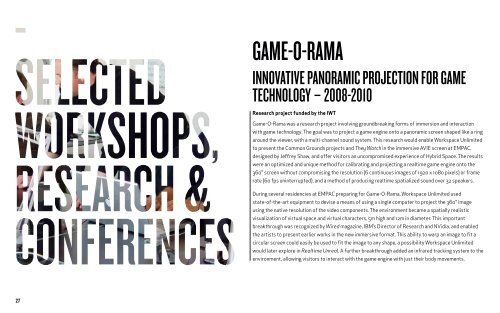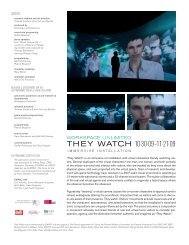Storyscape - Workspace Unlimited
Storyscape - Workspace Unlimited
Storyscape - Workspace Unlimited
You also want an ePaper? Increase the reach of your titles
YUMPU automatically turns print PDFs into web optimized ePapers that Google loves.
GAME-O-RAMA<br />
INNOVATIVE PANORAMIC PROJECTION FOR GAME<br />
TECHNOLOGY – 2008-2010<br />
Research project funded by the IWT<br />
Game-O-Rama was a research project involving groundbreaking forms of immersion and interaction<br />
with game technology. The goal was to project a game engine onto a panoramic screen shaped like a ring<br />
around the viewer, with a multi-channel sound system. This research would enable <strong>Workspace</strong> <strong>Unlimited</strong><br />
to present the Common Grounds projects and They Watch in the immersive AVIE screen at EMPAC,<br />
designed by Jeffrey Shaw, and offer visitors an uncompromised experience of Hybrid Space. The results<br />
were an optimized and unique method for calibrating and projecting a realtime game engine onto the<br />
360° screen without compromising the resolution (6 continuous images of 1920 x 1080 pixels) or frame<br />
rate (60 fps uninterrupted), and a method of producing realtime spatialized sound over 32 speakers.<br />
During several residencies at EMPAC preparing for Game-O-Rama, <strong>Workspace</strong> <strong>Unlimited</strong> used<br />
state-of-the-art equipment to devise a means of using a single computer to project the 360° image<br />
using the native resolution of the video components. The environment became a spatially realistic<br />
visualization of virtual space and virtual characters, 5m high and 12m in diameter. This important<br />
breakthrough was recognized by Wired magazine, IBM’s Director of Research and NVidia, and enabled<br />
the artists to present earlier works in the new immersive format. This ability to warp an image to fit a<br />
circular screen could easily be used to fit the image to any shape, a possibility <strong>Workspace</strong> <strong>Unlimited</strong><br />
would later explore in Realtime Unreal. A further breakthrough added an infrared tracking system to the<br />
environment, allowing visitors to interact with the game engine with just their body movements.<br />
VIRTUAL ART CENTER<br />
OF THE FUTURE<br />
2006<br />
Research project in collaboration with the Vooruit<br />
In light of a digital revolution, cultural institutions must take the appropriate steps to incorporate new<br />
media, and to provide opportunities for new possibilities of communication and interaction with the<br />
public. The Vooruit Cultural Centre, along with <strong>Workspace</strong> <strong>Unlimited</strong> and various strategic partners,<br />
organized this project to provide a technologically innovative answer to the social and scientific<br />
questions raised in this context. The goals were to research and construct a prototype of the cultural<br />
centre of the future, and to raise awareness of issues and challenges facing new media sectors, while<br />
offering newly-born digital art in addition to digitized existing productions and collections.<br />
The project sought to develop three practical applications: a web portal, a 3D digital platform, and a<br />
decentralized collective Customer Relationship Management application (CRM) that could serve the<br />
entire cultural sector. These initiatives included research into the international state-of-the-art of<br />
digital creation, presentation, communication and interaction, focussing on the effects on cultural<br />
participation, and a study of specific expectations and needs of various actors. The integration of<br />
these three demonstrators into one cohesive digital platform is the major innovation of this project.<br />
Ensuring interoperability was the primary objective in the development of the individual prototypes.<br />
Research for each prototype included their legal framework and possible business models,<br />
emphasizing distinctions of vertical and horizontal models of trust.<br />
BREAKING<br />
THE GAME<br />
2005-2006<br />
Workshop and series of virtual conferences<br />
<strong>Workspace</strong> <strong>Unlimited</strong> organized Breaking the Game, a series of interdisciplinary workshops and online<br />
symposia that brought together competing theorists and practitioners to build, debate and reflect on<br />
virtual worlds, computer gaming, immersive technologies, and new possibilities for artistic practice and<br />
experience. Taking place both online and offline, the workshops opened up the prospects of applying<br />
game modifications to everyday life, as virtual technologies mediate physical spaces and human<br />
movements in increasingly complex and dynamic ways.<br />
Networked across multiple cities, the conference and workshops where organized around three core<br />
themes: “Hybridity”, “Overclocking the City” and “The Virtual World as Interface to Self and Society”.<br />
Participants considered gaming and other virtual technologies in relationship to building and designing<br />
cities, navigating and experiencing urban life, constructing identities, and creating and maintaining<br />
social interaction.<br />
Architects, visual artists, filmmakers, choreographers, anthropologists and curators debated how these<br />
technologies and associated audiovisual cultures have impacted the work and ideas of their disciplines.<br />
For example, how might anthropological fieldwork and ethnography change if its practitioners<br />
composed 3D virtual worlds rather than essays and books; if anthropology’s disciplinary object was an<br />
updatable, media-rich, networked and navigable space, rather than a text? How might online gaming and<br />
modification continue to challenge and expand the boundaries of filmmaking and public performance?<br />
How could the design and implementation of a material building have an ongoing relationship to its<br />
networked and virtual double? Could the public’s social interactions with a virtual building impact the<br />
meaning, form, and function of the same building in physical space?<br />
27 28



